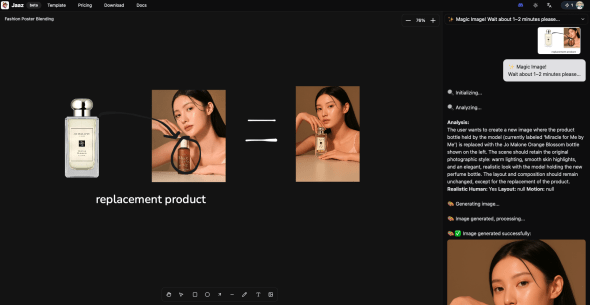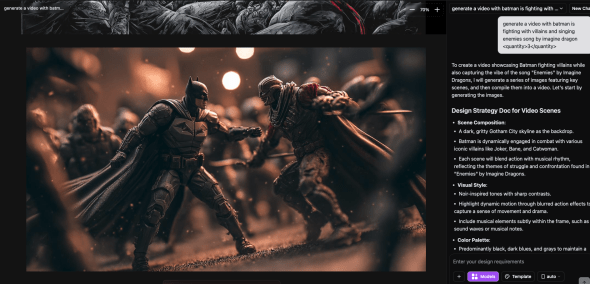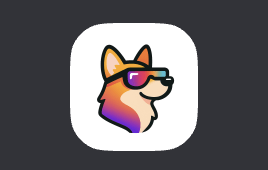Jaaz AI Design Agent: An Open-Source AI Creative Tool
Jaaz AI Design Agent is an open-source creative tool built to generate images, videos, and other visual content through an interactive “Magic Canvas.” Developed by GitHub user “11cafe” and introduced on Product Hunt in August 2025, this tool presents itself as a privacy-first, AI-native alternative to mainstream design platforms.
The Jaaz AI agent is useful for professional creators, design teams, and developers who need to produce a high volume of visual assets with greater efficiency. Its main value is its distinct multimodal interface, which allows users to sketch, chat, and point to articulate their ideas. This approach offers an alternative to the traditional, more manual workflows of template-based design software. By providing a self-hosted, open-source program, Jaaz addresses the growing need for customizable and private creative tools.
Best use cases of Jaaz AI Design Agent
- Marketing and Advertising Teams: For teams needing to create diverse assets for digital campaigns, the Jaaz AI Design Agent can streamline the production process. It can take a simple brief and produce dozens of ad variations and social media posts through its batch generation feature, addressing creative bottlenecks and reducing turnaround times.
- Content Creators and Solopreneurs: Individual creators can use Jaaz AI to quickly visualize and produce original illustrations, thumbnails, and storyboards without needing advanced design skills. The Magic Canvas allows for direct creation, turning rough sketches and text prompts into finished visual content, which saves time and software costs.
- UI/UX Designers: Designers can use the Jaaz AI agent for rapid prototyping and concept exploration. The tool enables them to quickly generate mockups, user interface elements, and design variations from simple inputs. This accelerates the ideation phase and allows for more creative experimentation early in the design process.
- Developers and Agencies: For those who need to integrate custom creative workflows, the open-source nature of Jaaz AI is a significant advantage. Developers can modify the code, integrate their preferred APIs, and build a bespoke design agent for specific client needs, offering a level of flexibility not possible with closed-source platforms.
Multimodal Magic Canvas: The interface that combines sketching, chat, and pointing is a direct and effective way to interact with a generative AI model.
Open-Source Flexibility: Being an "open source canva" alternative allows users to customize the tool, contribute to its development, and meet specific workflow requirements.
Privacy-First Architecture: As a self-hosted tool, Jaaz offers improved privacy and data security compared to cloud-based design platforms.
Efficient Batch Processing: The ability to automate the creation of multiple images from a single set of instructions is a major time-saver for large-scale content production.
Cost-Effective Core: The main software is free to use for those willing to handle the technical setup, making it an accessible option.
AI-Native Design: Unlike traditional tools with AI features added on, the Jaaz AI agent is built from the ground up for AI generation, leading to a more direct creative workflow.
Significant Technical Setup: Users must configure their own Large Language Model (LLM) and image generation APIs, which is a steep barrier for non-technical users.
Limited API Support: The tool currently lacks native support for a wide range of popular and powerful generative models like Midjourney.
No Integrated Asset Management: Jaaz AI does not have a built-in system for storing, organizing, and reusing creative assets, a standard feature in competing platforms.
Lacks Video Generation: It does not yet support video generation APIs, limiting its output to static images.
New and Unproven: As a recent arrival, the tool has a small user base, lacks detailed tutorials, and is not yet listed on major review platforms.
-
Magic Canvas: An interactive, multimodal canvas where users generate designs by sketching, using text prompts, and pointing to refine elements.
-
Batch Image Generation: An automated function that produces multiple visual assets from a single prompt or set of instructions.
-
Multimodal Generation: Capable of creating a variety of static visual content, including posters, images, and storyboards.
-
Open-Source Codebase: The platform’s full source code is on GitHub, allowing for community contributions and complete customization.
-
Local-First Operation: Designed to be run on a user’s local machine, giving users control over data and assets.
-
API Integration: Connects with various LLM and image generation APIs to power its creative output.
-
Chat-Based Interface: A core component of the Magic Canvas that allows users to articulate their creative vision using natural language.
-
Sketch-to-Image Functionality: Translates rough user sketches into fully rendered, AI-generated images.
 Homepage Jaaz AI
Homepage Jaaz AI
 Jaaz AI Magic Canva
Jaaz AI Magic Canva
 Image Created By Jaaz AI
Image Created By Jaaz AI
Frequently Asked Questions
-
What is Jaaz AI Design Agent?
Jaaz AI Design Agent is an open-source software tool that helps users create visual content like images and posters using an interactive AI-powered canvas. -
Is Jaaz AI free to use?
The core Jaaz AI software is free because it is open-source, but users must pay for the third-party LLM and image generation APIs required to make it work. -
Who is the target audience for Jaaz AI?
Jaaz AI targets professional creators, design teams, and developers who are comfortable with technical setups and want a customizable, private AI design tool. -
What are the main limitations of Jaaz AI?
Its primary limitations are the complex initial setup, a lack of support for many popular AI models, no video generation, and the absence of an asset management system. -
How is the Jaaz AI agent different from Canva?
Jaaz is an “open source canva” alternative focused on generative creation via a multimodal canvas, whereas Canva is a template-based, cloud-hosted platform with a broader, less technical user base. -
Is Jaaz better than Canva?
Whether Jaaz AI is “better” than Canva depends entirely on the user’s needs. Canva is better for beginners, non-technical users, and teams who need a reliable, easy-to-use platform with a massive library of templates and strong collaboration features. Jaaz AI is better for technically proficient users who prioritize privacy, customization, and a generative-first workflow. For users who want to build a custom, self-hosted design tool, Jaaz offers more flexibility, but for users who need to create standard designs quickly and easily, Canva remains the superior choice.
Tech Pilot’s Verdict on Jaaz AI Design Agent
I’ve been observing the development of AI agents, and the Jaaz AI Design Agent caught my attention with its description as an “open-source Canva for AI natives.” My goal was to assess whether this tool is a practical creative program today or a concept of future potential. Since a hands-on test requires an involved technical setup, I focused my evaluation on its architecture, stated capabilities, and place within the current market.
First, I examined the “Magic Canvas” concept. The idea of sketching a layout, telling the AI to “add a perfume bottle and an image of a model holding a perfume bottle,” and then simply drawing an arrow to place the generated bottle into the model’s hand is the direct workflow many have been waiting for. This multimodal method is Jaaz AI’s key feature. It could alter creative ideation by making the process a conversation between the user and the AI. I simulated this by mocking up a workflow for a social media campaign. The ability to generate ten different background styles for a single product sketch in seconds is a useful function.
However, this is where the practical limitations become clear. The potential of the Magic Canvas is constrained by its integrations. The lack of support for certain premier models like Midjourney means users are limited to a smaller pool of image generators. Furthermore, the absence of an integrated asset management system is a major workflow inconvenience. After generating twenty product shots, you’re left to manage those files on your own, a step backward from the connected environment of a tool like Canva.
The pricing model is also a consideration. “Free” is an attractive entry point, but it’s not the whole story. The real cost comes from the API usage of the LLMs and image models you plug in, which can become expensive for high-volume work. This positions the Jaaz AI agent not as a free tool, but as a flexible framework where you bring your own engine and fuel.
Top Alternatives to Jaaz AI Design Agent
- Canva is the established market leader. It offers a large library of templates and assets, collaboration features, and a user-friendly interface that requires no technical skill. While Canva has integrated AI features, its core is template-based, making it a better choice for users who need reliability and a large content library over the generative flexibility of Jaaz AI.
- Lovart is a more direct competitor, presented as a premium AI design agent for professionals. Like Jaaz, it uses natural language to generate designs, but it is a closed-source, commercial product with a focus on brand identity and a curated set of integrated AI models. Lovart is likely a better option for agencies and brands who want a powerful, ready-to-use AI creative director without the difficulty of self-hosting.
- Manus represents the broader category of general-purpose AI agents. While not a dedicated design tool, its interface for task automation has influenced tools like Jaaz. Manus is a better choice for users whose needs go beyond design, requiring an agent that can perform research, manage schedules, or automate other digital tasks.
Final Verdict
The Jaaz AI Design Agent is a forward-thinking and useful tool for a very specific type of user—the technically proficient creator who values privacy, customizability, and an AI-native workflow. It is not a direct replacement for Canva for the general public, at least not yet. The setup is a significant hurdle, and its feature set is still developing. However, for those willing to use its open-source nature, the Jaaz AI Design Agent offers a flexible look at the future of creative design.

